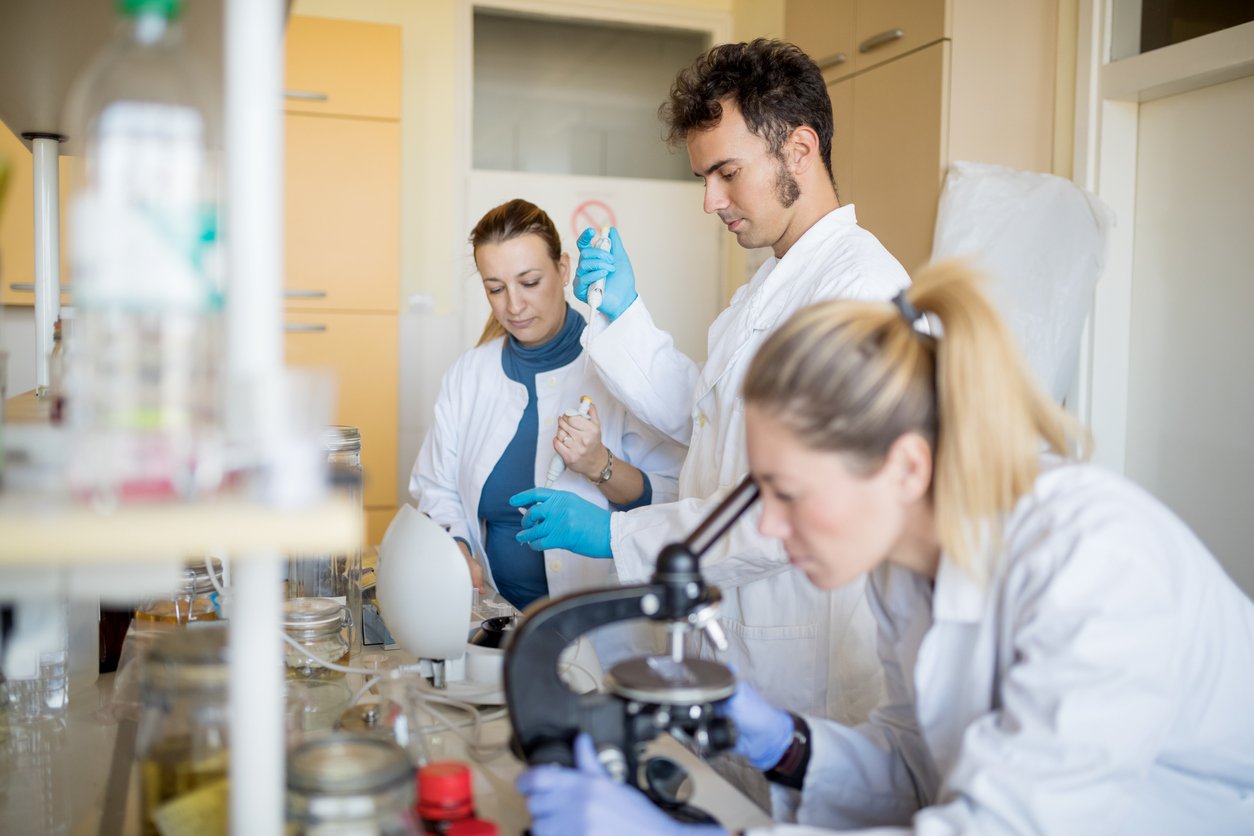I would bet that the last time you went grocery shopping, you picked out a number of food items that appeared to be pretty healthy. And it’s likely that when you read the ingredient lists, many of them contained “natural flavors.” Cool, you might think. What’s better than natural? It’s probably some fruit or vegetable extract, like cinnamon or turmeric. Heck, it’s probably even good for me, right?
Unfortunately, “natural” flavors can contain chemicals, carrier solvents, and preservatives. And they could be made from just about anything other than petroleum. So, what’s the deal?
What are Natural Flavors?
The official FDA definition of a natural flavor is “the essential oil, oleoresin, essence or extractive, protein hydrolysate, distillate, or any product of roasting, heating, or enzymolysis, which contains the flavoring constituents derived from a spice, fruit, or fruit juice, vegetable or vegetable juice, edible yeast, herb, bark, bud, root, leaf or similar plant material, meat, seafood, poultry, eggs, dairy products, or fermentation products thereof, whose significant function in food is flavoring rather than nutritional.”
Whew. That was a mouthful. And if your takeaway from that definition is that “natural flavor” could pretty much mean anything, I’d have to agree. And that’s pretty disconcerting for someone who likes to know what’s in my food. Especially since these substances are pretty much everywhere.
There are over 2,500 chemically defined flavor substances used in the United States and Europe. Despite the fact that “natural flavors” are comprised of just about anything used for flavor, they are all lumped together under one name. In fact, out of 80,000 foods in Environmental Working Group’s Food Scores database, “natural flavors” is the 4th most common ingredient of all.
Why are Natural Flavors Used?
Why are natural flavors used so much, and in so many things? In short, because manufacturers believe they make food taste better, which is good for sales. And in many cases, they are also a cheap way to cover up bad-tasting food. For example, a piece of ripe fruit can taste amazing. But if a farm picks its fruit too green, and ships it 10,000 miles, it may lack flavor, color, and sweetness. If a company can add some natural flavors (plus a hefty dose of sugar and maybe even some food dye), suddenly the food will taste sweet and flavorful, and look brightly colored. The result is a poor substitute for real food, but these practices can be profitable, and most consumers will be fooled.
Creating these substances is big business. The food industry employs what are called “flavor scientists,” whose main job is to mimic the taste of different foods and make them more flavorful and even addictive to consumers.
In other words, these flavorings are used to keep you coming back for more.
Natural Flavor Definitions Vary Around the Globe
There are some differences between the natural flavor ingredients in the United States and those used in the European Union. In the EU, the natural flavor has to originate from a vegetable, animal, or microbiological source and must be made through a traditional food preparation process. But in the US, natural flavors can be an essential oil, oleoresin, essence or extractive, protein hydrolysate, distillate, or any product of roasting, heating or enzymolysis (I had to look up that last word. It means fermentation caused by an enzyme).
The natural flavors in other countries differ still more. India requires that they’re derived exclusively from vegetables and doesn’t allow microbiological processes. In Japan, natural flavors can be made from a limited list of plant and animal sources. In Canada, any flavorings that are not made from plant, animal, or microbiological sources have to be called “artificial flavorings.” In 2002, regulations in Australia and New Zealand were revised to remove any references to natural flavors, making it impossible to differentiate between artificial and natural flavors anymore.
What’s the Difference Between Natural Flavors and Artificial Flavors?
Interestingly, natural and artificial flavors aren’t actually all that different from one another.
Both are generally made in a lab setting, but while artificial flavors are derived from petroleum and other substances you can’t eat, natural flavors are generally made, at least originally, from natural sources. Chemically, natural and artificial flavors are often the same molecules — the difference is the process and the raw ingredients they’re made from, more than the end product.
To make a natural flavor without actually using the imitated food itself, flavor scientists look for cheaper sources that mimic the natural food’s molecular “fingerprint.”
Sometimes, natural compounds aren’t actually derived from the flavor they’re used for. A good (or bad) example of this is McDonald’s beef flavoring, which is derived from milk and wheat, among other substances. Similarly, African violets may be used to produce “watermelon” flavoring, and volatiles from grapefruit may be used to produce so-called “passion fruit” flavor. Fermented, genetically-engineered yeast is often used to make “vanilla” and “saffron” flavors. Artificial vanillin flavor is usually made from compounds called guaiacol or lignin, which come from distilled wood tar or tree resin — or wood pulp. In each case, a base is often diluted and may be combined with other flavor and scent blends made in the lab.
At the end of the day, many natural flavors are highly processed and contain a host of chemical additives. In fact, there could be as many as 100 chemicals in a single natural flavor.
What About Organic Natural Flavors?
Okay, so what about natural flavors that carry an organic label?
In order to be considered certified organic, the natural flavor has to contain at least 95% organically grown base ingredients. And contain no more than 5% non-organic base ingredients in its composition. It also cannot be made using synthetic extraction solvents. And it can’t contain any synthetic carriers or artificial preservatives. Certified organic natural flavors are non-GMO, and no ionizing radiation is used in their manufacturing process.
The main perk is that most of the components used are grown organically. But according to the USDA, organic natural flavors (which contain 95-100% organically grown ingredients) must be made “from natural sources and have not been chemically modified in a way which makes them different than their natural chemical state” and are not allowed to be made with synthetic solvents or artificial preservatives. Organic natural flavors cannot contain the additives propylene glycol, polyglycerol esters of fatty acids, mono- and di-glycerides, benzoic acid, polysorbate 80, medium-chain triglycerides, BHT, BHA, or triacetin. So, while there are definitely advantages to organic natural flavors, they still may contain some less than desirable components.
How Are Natural and Artificial Flavors Regulated?
The FDA’s Food Additives and Amendment Act (FAA) of 1958 states that the FDA is responsible for ensuring the safety of new food additives, including flavors, before they can be used in food products. But the FDA essentially punts on the issue by allowing most flavorings to be designated as “generally recognized as safe” (GRAS).
The trouble is, GRAS substances are not really regulated. These ingredients can actually bypass any FDA safety reviews. It’s a mechanism by which the manufacturers can decide that a substance is “safe” all on their own.
The icing on the GRAS oxymoron cake? Manufacturers can do all of this without even telling the FDA that they’re using a substance in food. That’s right; the FDA may not even know a chemical exists because the company making it never told them (and didn’t have to). Some experts estimate that the FDA may be unaware of around 1,000 chemicals currently being used in the food system.
Basically, companies just have to conclude that the flavoring wouldn’t cause harmful health effects when consumed in amounts expected for humans. This is often determined through the company’s own funded research, or “expert panels” that they assemble at their own discretion, which typically include company employees or contractors. When the panel is done, the company still gets to decide whether to share its conclusions with the FDA.
What’s more, the Government Accountability Office released a report in 2010 saying that decisions regarding whether an ingredient should be added to the GRAS list could legitimately be influenced by financial or business associations. Although the FDA has guidelines in place to prevent conflicts of interest from FDA employees and expert advisory panels, this doesn’t apply to expert panels formed by private companies used to reach GRAS consensus decisions. In other words, if there’s money to be made, then there are loopholes that can make it okay for a company to let that influence their decision — regardless of any possible dangers to public health.
Common Natural Flavors and Their Health Effects
All of this means that there is a lot we don’t know. There only rarely has been testing by any objective third parties. And since almost everybody is eating natural flavors every day, it’s hard to discern what the health consequences might be. So, if the cumulative impact of certain natural flavors, over the course of decades, did turn out to cause cancer or autoimmune diseases — how would we ever figure that out?
Meanwhile, there are some that are sources of concern based on what we do know. Here are some of the most common natural flavors and their known health risks.
Diacetyl
This one is best known as natural butter flavoring. Unfortunately, when you consume diacetyl, you may be in for more than buttery fingers. A condition sometimes referred to as “popcorn lung” has been shown to affect workers in microwave popcorn factories. According to the CDC, studies have found an association between exposure to diacetyl vapor over time in microwave popcorn facilities and workers developing abnormal lung function and shortness of breath. Animal studies have further linked diacetyl toxicity to airway damage.
Monosodium Glutamate (MSG)
Probably best known for being added to many Chinese foods, MSG is generally used as a flavor enhancer. When it is used in this way in packaged foods, it is supposed to be listed on the ingredient label. However, glutamate byproducts like MSG can be found in natural flavors, in which case their presence won’t be spelled out on the label. MSG consumption has been linked with obesity, metabolic disorders, Chinese Restaurant Syndrome, neurotoxic effects, and reproductive organ damage.
Citral
Best known for its use as a natural lemon flavoring, citral is a skin and mucous membrane irritant. Several human toxicity studies have found citral to be a strong primary irritant when inhaled and used in skin patch tests. Environmental Working Group also notes some concerns regarding citral and reproductive toxicity.
Methyl N-Acetyl Anthranilate
Commercially known as a common natural berry flavoring, this one has been shown to cause phototoxicity in some people. What this means is that when consumption of this chemical is combined with exposure to sunlight, some people get a skin irritation that looks like a bad sunburn.
Castoreum
This one has most often been used in strawberry-flavored foods and drinks. Studies show that it doesn’t necessarily have bad health effects when consumed in low amounts. However, it certainly has a gross factor. Castoreum is an anal secretion beavers use to mark their territories, that also happens to smell like vanilla. Fortunately, its use in foods has significantly decreased since the 1980s. This appears to be largely because more food companies began seeking Kosher approval, and this ingredient doesn’t fit the bill. It’s also rare and therefore expensive. Still, it might be lurking in some foods.
Natural Flavors and Food Allergens
Many flavor additives could be dangerous for people with food allergies, too. The FDA requires that companies disclose if their product contains one of the eight major food allergens: milk, eggs, wheat, soy, fish, shellfish, peanuts, or tree nuts. But what if you’re allergic to something else that isn’t on that list? It could be used in the process of creating natural flavors, and the manufacturer won’t be required to disclose it. It could be made from any number of things, including potential allergens.
If you experience an allergic reaction after eating a “naturally-flavored” food, it may very well be because of the natural flavors. Get in touch with the manufacturer directly and ask them if the allergen you’re concerned about is used to make their natural flavors. The best way to avoid this altogether, especially if you have a severe food allergy, is to choose natural flavor-free whole foods as much as possible. This way, you don’t have to worry about additives at all — especially undisclosed and potentially dangerous ones.
What You Can Do
The first line of defense against dangerous ingredients is to read food labels so you can make informed choices. But when it comes to “natural flavors,” that’s more difficult because they could be literally almost anything. For many people, this might be a reason to avoid “natural flavors” altogether. But if you eat anything packaged, you’ll find this is easier said than done because they are so widely used.
And if you’re frustrated with the use of natural flavors and other chemicals in the food system, there are some steps you take. You can support products and brands that are natural flavors-free. You can call or write to companies, or post on their social media pages, letting them know you care, asking them to disclose which natural flavors they actually use, or to stop using them altogether. And you can boycott products that use natural flavors, and let the manufacturer know why.
If enough people speak up, before long, companies will begin advertising with pride on package labels that they are free of added natural and artificial flavors.
We can make this happen.
This is also a great opportunity to find alternatives to add more flavor to your food. For instance, use real herbs and spices — and real extracts. Food can be so flavorful on its own thanks to Mother Nature — the original (and still the best!) flavor scientist. And once you adopt a diet full of less processed foods, you might be surprised at how your taste buds adapt. Apples and blueberries and sweet potatoes might start tasting amazing. And your desire for added flavors may simply go away. The truth is that a real organic peach, picked at the peak of ripeness, tastes infinitely more “peachy” than any natural peach flavoring ever could.
Tell us in the comments:
- Are you concerned about the widespread use of natural flavors?
- Have you ever had an adverse reaction to natural flavors?
- What are your favorite way to add flavor to foods?
Featured Image: iStock.com/gorodenkoff






